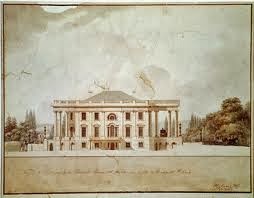A Republican Capital
Chapter 6 of Wulf’s book shows us the beginnings of the U.S. Capital. She begins by telling how the location was selected. With two great debates going on in congress, the first being Hamilton’s financial plan, and the second being the future location of the nations capital. The northern states, who mostly agreed with the financial plan, wanted the capital to be in a city much like New York. The southern states, which mostly opposed the financial plan, wanted the capital in closer to the south. This led to a compromise between Jefferson and Hamilton. Jefferson agreed to not block the financial plan, if Hamilton agreed to have the capital build closer to the south. The current location along the Potomac River was chosen.
George Washington, who was now no longer President, was able to keep his influence in government alive. Washington was able to get what he wanted when it came to the look of the nation’s capital. Even though Jefferson did disagree with Washington’s vision of the city, Jefferson never openly opposed Washington’s ideas. Washington envisioned a grand imposing city that showed power and wealth. Jefferson, sticking to his farmer heritage, wanted a simple town that would grow organically over time, and was as out of the way as possible.
No matter the disagreement, George Washington was able to get his way. He hired Charles Pierre L’Enfant to design the city. L’Enfant designed a very large city that infused political ideology. L’Enfant remains the designer until he destroys a house of a wealthy land owner without permission because he said that it was in the middle of a street that was to be built. After this L’Enfant was forced to resign.
Something that interested me from this weeks reading was the lack of interest John Adams shows in the development of the nations capital. Instead he decided to turn his focus on the possibility of war with France. Thomas Jefferson, now as Vice President, also shows this same lack of interest. Wulf seems to show Jefferson’s lack of interest as a ploy to get his vision of the city built when the magnificent city Washington invasions is way behind schedule.
Upon Washington’s dies 1799, Adams now shows interest in the building of Washington. Adams wants a magnificent garden in front of the White House more than he wants a grand interior. However, this never becomes a reality.
After Adams’ first term of office, Jefferson uses political tactics to become 3rd president. An interesting thing is that Jefferson does not build garden at white house. This is possibly due to the fact of him wanting Washington to be “neither grandeur nor show power.” Jefferson did not want the White House to resemble a palace, such as Versailles. As President, Jefferson dressed down to a more common citizen look. He wanted the capital to resemble what he considered to be a “Republican Capital.”
In the spring of 1807, Jefferson finally looks at building a garden at the white house. Jefferson envisioned an all-American garden. Due to financial restraints, this garden can never be built during Jefferson’s presidency.
After spending much time in Washington throughout my lifetime, I thought I knew a great deal about the history of the city. I knew that Charles Pierre L’Enfant was the person that designed the layout of the city, but I had no idea that there were conflicting ideas of what the nation’s capital should look like. Wulf gives a brilliant insight into how gardening was a dispute in the development of Washington.


No comments:
Post a Comment